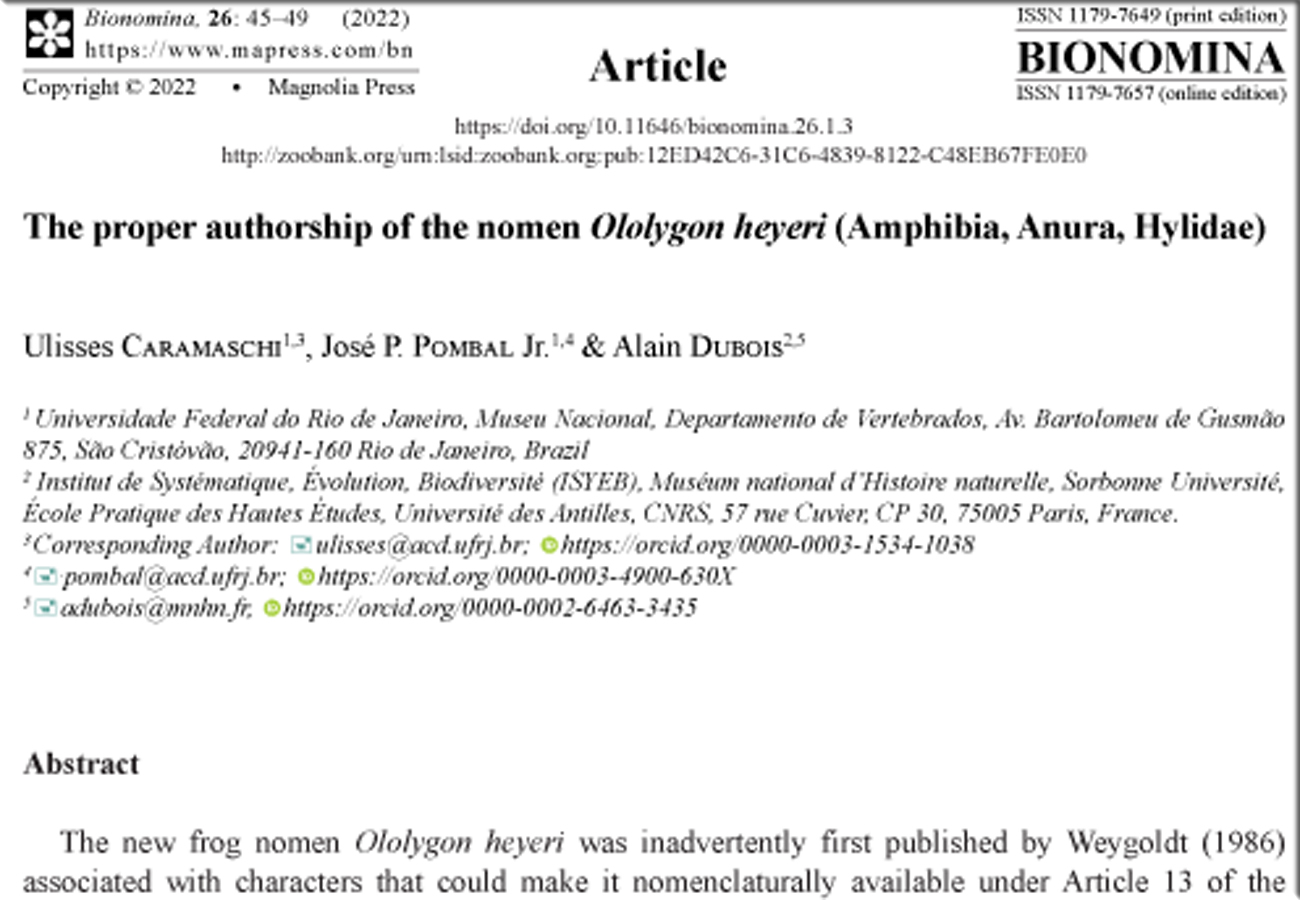Abstract
The new frog nomen Ololygon heyeri was inadvertently first published by Weygoldt (1986) associated with characters that could make it nomenclaturally available under Article 13 of the Code, but the epithet heyeri was consistently written there between quotation marks, which makes it unavailable under Articles 8.3 and 11.5. This nomen was made available in the formal description of the species by Peixoto & Weygoldt (1987). Under Article 73.1.1, the designation in the latter work of a ‘lectotype’ for this nominal species should be interpreted as a holotype designation.
References
Anonymous [International Commission on Zoological Nomenclature] (1999) International code of zoological nomenclature. ‘Fourth edition’. London (International Trust for Zoological Nomenclature): i–xxix + 1–306.
Bonaparte, C. L. (1838) Rana temporaria. Ranocchia rossa. In : Iconographia della fauna italica per le quattro classi degli animali vertebrati, vol. 2, [fasc. 22]. Roma (Salviucci): [203‒204], pl. [46].
Dubois, A. (1984) Notes sur les Grenouilles brunes (groupe de Rana temporaria Linné, 1758). III. Un critère méconnu pour distinguer Rana dalmatina et Rana temporaria. Alytes, 3: 117‒124.
Dubois, A. (2000) Synonymies and related lists in zoology: general proposals, with examples in herpetology. Dumerilia, 4 (2): 33–98.
Dubois, A. (2015) Zoological nomina in the century of extinctions: new proposals. Bionomina, 8: 11–53. <https://doi.org/10.11646/bionomina.8.1.2>.
Duellman, W. E., Marion, A. B. & Hedges, S. B. (2016) Phylogenetics, classification, and biogeography of the treefrogs (Amphibia: Anura: Arboranae). Zootaxa, 4104: 1–109. <https://doi.org/10.11646/zootaxa.4104.1.1>.
Duellman, W. E. & Wiens, J. J. (1992) The status of the hylid frog genus Ololygon and the recognition of Scinax Wagler, 1830. Occasional Papers of the Museum of natural History, University of Kansas, 151: 1–23.
Linnaeus, C. (1758) Systema naturae per regna tria naturae, secundum classes, ordines, genera, species, cum characteribus, differentiis, synonymis, locis. Editio decima, reformata. Tomus 1. Holmiae (Laurentii Salvii): [i–iv] + 1–824. <https://doi.org/10.5962/bhl.title.542>.
Peixoto, O. L. & Weygoldt, P. (1987) Notes on Ololygon heyeri Weygoldt 1986 from Espirito Santo, Brazil. Senckenbergiana biologica, 68: 1–9.
Pombal, Jr., J. P. & Gordo, M. (1991) Duas novas espécies de Hyla da Floresta Atlântica no Estado de São Paulo (Amphibia, Anura). Memórias do Instituto Butantan, 53: 135–144.
Poynton, J. C. (1963) Descriptions of southern African amphibians. Annals of the Natal Museum, 15: 319–332.
Segalla, M. V., Caramaschi, U., Cruz, C. A. G., Garcia, P. C. A., Grant, T., Haddad, C. F. B., Santana, D. J., Toledo, L. F. & Langone, A. (2019) Brazilian amphibians: list of species. Herpetologia brasileira, 8: 65–96. <www.sbherpetologia.org.br>. [Accessed on 25 May 2010].
Vences, M., Glaw, F. & Böhme, W. (1999) A review of the genus Mantella (Anura, Ranidae, Mantellinae): taxonomy, distribution and conservation of Malagasy poison frogs. Alytes, 17 (1–2): 3–72.
Wager, V. A. (1961) The plain Rana. African Wildlife, 15: 51–155.
Weygoldt, P. (1986) Beobachtungen zur Ökologie und Biologie von Fröschen an einem neotropischen Bergbach. Zoologische Jahrbücher, Systematik, Ökologie und Geographie, 113: 429–454.


